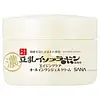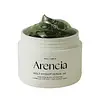What's inside
What's inside
 Key Ingredients
Key Ingredients

 Benefits
Benefits

 Concerns
Concerns

No concerns
 Ingredients Side-by-side
Ingredients Side-by-side

Water
Skin ConditioningGlycerin
HumectantButylene Glycol
HumectantAlcohol Denat.
AntimicrobialCyclopentasiloxane
EmollientCetyl Ethylhexanoate
EmollientHydrogenated Castor Oil Stearate
Skin ConditioningMilk Ferment
Skin ConditioningGlycine Max Seed Extract
Skin ConditioningSoy Protein Phthalate
EmollientRetinol
Skin ConditioningSoy Isoflavones
Skin ConditioningRetinyl Palmitate
Skin ConditioningCeramide Ng
Skin ConditioningVinyl Dimethicone/Methicone Silsesquioxane Crosspolymer
PEG-40 Hydrogenated Castor Oil
EmulsifyingPEG-60 Hydrogenated Castor Oil
EmulsifyingSodium Ascorbate
AntioxidantArginine
MaskingCarbomer
Emulsion StabilisingGlycyrrhiza Glabra Root Extract
BleachingDimethiconol
EmollientSqualane
EmollientStearic Acid
CleansingGlyceryl Stearate
EmollientSodium Stearoyl Glutamate
CleansingCetearyl Alcohol
EmollientPhytosterols
Skin ConditioningTocopherol
AntioxidantCaprylic/Capric Triglyceride
MaskingSodium Polyacrylate
AbsorbentPolysorbate 80
EmulsifyingLecithin
EmollientPotassium Hydroxide
BufferingHydrogenated Lecithin
EmulsifyingPhenoxyethanol
PreservativeWater, Glycerin, Butylene Glycol, Alcohol Denat., Cyclopentasiloxane, Cetyl Ethylhexanoate, Hydrogenated Castor Oil Stearate, Milk Ferment, Glycine Max Seed Extract, Soy Protein Phthalate, Retinol, Soy Isoflavones, Retinyl Palmitate, Ceramide Ng, Vinyl Dimethicone/Methicone Silsesquioxane Crosspolymer, PEG-40 Hydrogenated Castor Oil, PEG-60 Hydrogenated Castor Oil, Sodium Ascorbate, Arginine, Carbomer, Glycyrrhiza Glabra Root Extract, Dimethiconol, Squalane, Stearic Acid, Glyceryl Stearate, Sodium Stearoyl Glutamate, Cetearyl Alcohol, Phytosterols, Tocopherol, Caprylic/Capric Triglyceride, Sodium Polyacrylate, Polysorbate 80, Lecithin, Potassium Hydroxide, Hydrogenated Lecithin, Phenoxyethanol
Water
Skin ConditioningButylene Glycol
HumectantPropanediol
SolventGlycerin
Humectant1,2-Hexanediol
Skin ConditioningNiacinamide
SmoothingMethylpropanediol
SolventAmmonium Acryloyldimethyltaurate/Vp Copolymer
Acrylates/C10-30 Alkyl Acrylate Crosspolymer
Emulsion StabilisingArginine
MaskingDextrin
AbsorbentEthylhexylglycerin
Skin ConditioningGlyceryl Acrylate/Acrylic Acid Copolymer
HumectantAdenosine
Skin ConditioningPvm/Ma Copolymer
Emulsion StabilisingGardenia Florida Fruit Extract
Skin ConditioningSodium Hyaluronate
HumectantHyssopus Officinalis Extract
Masking3-O-Ethyl Ascorbic Acid
Skin ConditioningSodium Ascorbyl Phosphate
AntioxidantAscorbic Acid
AntioxidantAscorbyl Glucoside
AntioxidantTocopherol
AntioxidantPanthenol
Skin ConditioningPyridoxine
Skin ConditioningLinum Usitatissimum Seed Extract
PerfumingOryza Sativa Extract
AbsorbentHydrogenated Lecithin
EmulsifyingCeramide NP
Skin ConditioningGlycosphingolipids
EmollientSodium Hyaluronate Crosspolymer
HumectantPotassium Hyaluronate
Skin ConditioningHydroxypropyltrimonium Hyaluronate
Hydrolyzed Sodium Hyaluronate
Skin ConditioningHydrolyzed Hyaluronic Acid
HumectantHyaluronic Acid
HumectantPentylene Glycol
Skin ConditioningSodium Acetylated Hyaluronate
HumectantWater, Butylene Glycol, Propanediol, Glycerin, 1,2-Hexanediol, Niacinamide, Methylpropanediol, Ammonium Acryloyldimethyltaurate/Vp Copolymer, Acrylates/C10-30 Alkyl Acrylate Crosspolymer, Arginine, Dextrin, Ethylhexylglycerin, Glyceryl Acrylate/Acrylic Acid Copolymer, Adenosine, Pvm/Ma Copolymer, Gardenia Florida Fruit Extract, Sodium Hyaluronate, Hyssopus Officinalis Extract, 3-O-Ethyl Ascorbic Acid, Sodium Ascorbyl Phosphate, Ascorbic Acid, Ascorbyl Glucoside, Tocopherol, Panthenol, Pyridoxine, Linum Usitatissimum Seed Extract, Oryza Sativa Extract, Hydrogenated Lecithin, Ceramide NP, Glycosphingolipids, Sodium Hyaluronate Crosspolymer, Potassium Hyaluronate, Hydroxypropyltrimonium Hyaluronate, Hydrolyzed Sodium Hyaluronate, Hydrolyzed Hyaluronic Acid, Hyaluronic Acid, Pentylene Glycol, Sodium Acetylated Hyaluronate
 Reviews
Reviews

Ingredients Explained
These ingredients are found in both products.
Ingredients higher up in an ingredient list are typically present in a larger amount.
Arginine is an amino acid that is important for human development. Your body uses is it to produce hair keratin and skin collagen.
As a cosmetic ingredient, Arginine has antioxidant properties and can also help repair damaged skin. This ingredient is derived either synthetically or from animals.
Arginine isn't fungal acne safe when used in the presence of other lipids (fats, fatty acids, oils, esters, etc). Oils and fats occur naturally within the skin, so take caution when using Arginine if you're prone to fungal acne.
Learn more about ArginineButylene Glycol (or BG) is used within cosmetic products for a few different reasons:
Overall, Butylene Glycol is a safe and well-rounded ingredient that works well with other ingredients.
Though this ingredient works well with most skin types, some people with sensitive skin may experience a reaction such as allergic rashes, closed comedones, or itchiness.
Learn more about Butylene GlycolGlycerin is already naturally found in your skin. It helps moisturize and protect your skin.
A study from 2016 found glycerin to be more effective as a humectant than AHAs and hyaluronic acid.
As a humectant, it helps the skin stay hydrated by pulling moisture to your skin. The low molecular weight of glycerin allows it to pull moisture into the deeper layers of your skin.
Hydrated skin improves your skin barrier; Your skin barrier helps protect against irritants and bacteria.
Glycerin has also been found to have antimicrobial and antiviral properties. Due to these properties, glycerin is often used in wound and burn treatments.
In cosmetics, glycerin is usually derived from plants such as soybean or palm. However, it can also be sourced from animals, such as tallow or animal fat.
This ingredient is organic, colorless, odorless, and non-toxic.
Glycerin is the name for this ingredient in American English. British English uses Glycerol/Glycerine.
Learn more about GlycerinHydrogenated Lecithin is created from the hydrogenation of lecithin (a group of phospholipids). Hydrogenation is a chemical reaction between hydrogen and another element.
This ingredient is an emollient and emulsifier. As an emollient, it helps soften skin by trapping moisture within. As an emulsifier, it prevents oil and water ingredients from separating.
Tocopherol (also known as Vitamin E) is a common antioxidant used to help protect the skin from free-radicals and strengthen the skin barrier. It's also fat soluble - this means our skin is great at absorbing it.
Vitamin E also helps keep your natural skin lipids healthy. Your lipid skin barrier naturally consists of lipids, ceramides, and fatty acids. Vitamin E offers extra protection for your skin’s lipid barrier, keeping your skin healthy and nourished.
Another benefit is a bit of UV protection. Vitamin E helps reduce the damage caused by UVB rays. (It should not replace your sunscreen). Combining it with Vitamin C can decrease sunburned cells and hyperpigmentation after UV exposure.
You might have noticed Vitamin E + C often paired together. This is because it is great at stabilizing Vitamin C. Using the two together helps increase the effectiveness of both ingredients.
There are often claims that Vitamin E can reduce/prevent scarring, but these claims haven't been confirmed by scientific research.
Learn more about TocopherolWater. It's the most common cosmetic ingredient of all. You'll usually see it at the top of ingredient lists, meaning that it makes up the largest part of the product.
So why is it so popular? Water most often acts as a solvent - this means that it helps dissolve other ingredients into the formulation.
You'll also recognize water as that liquid we all need to stay alive. If you see this, drink a glass of water. Stay hydrated!
Learn more about Water